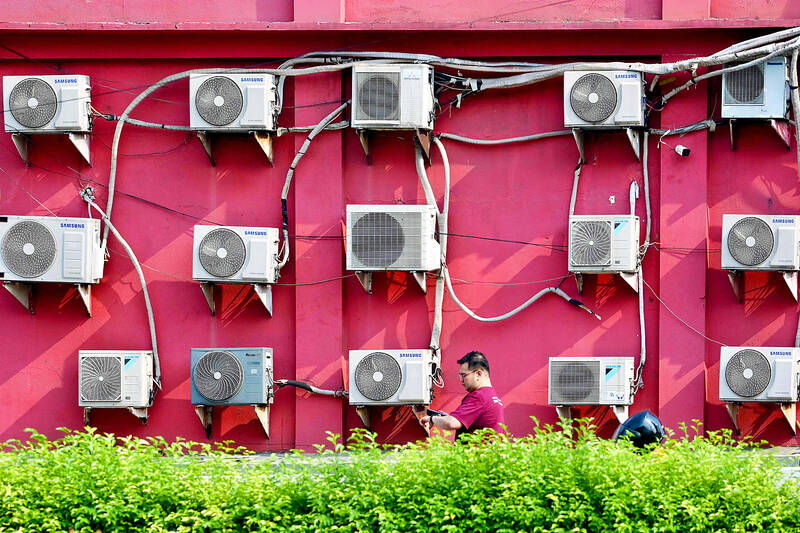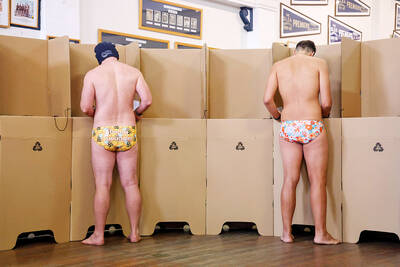Record-breaking heat last month that prompted governments in Asia to close schools offers fresh evidence of how climate change is threatening the education of millions of children.
The arrival of seasonal rains has now brought relief to some parts of the region, but experts warn the broader problem remains, and many countries are poorly prepared to handle the impacts of climate change on schooling.
Asia is warming faster than the global average, and climate change is producing more frequent, longer and more intense heat waves.

Photo: AFP
However, heat is not the only challenge.
A warmer atmosphere holds more moisture, which can result in heavy rains and flooding.
This can damage schools or put them out of commission while they are used as shelters.
Hot weather can also drive wildfires and spikes in air pollution, which have caused school closures everywhere from India to Australia.
“The climate crisis is already a reality for children in East Asia and the Pacific,” UNICEF said last year.
Mohua Akter Nur, 13, is living proof of that claim, sweltering in a one-room home in Bangladesh’s capital, Dhaka, after her school closed.
Intermittent electricity means she cannot even rely on a fan to cool the cramped dwelling.
“The heat is intolerable,” she said. “Our school is shut, but I can’t study at home.”
Last month marked the 11th straight month of record global heat, and the pattern is clear in Bangladesh, said Shumon Sengupta, country director for non-governmental organization Save the Children.
“Not only are the temperatures higher, the duration of the high temperatures is much longer,” he said. “Previously, few areas used to have these heat waves, now the coverage of the country is much higher.”
Schools across much of Asia are simply not equipped to deal with the growing consequences of climate change.
Bangladesh’s urban schools can be sturdy, but are often overcrowded with little ventilation, Sengupta said.
In rural areas, corrugated metal roofs can turn classrooms into ovens and electricity for fans is unreliable.
In Bangladesh and elsewhere, students often walk long distances to and from school, risking heatstroke in the process.
However, closing schools comes with serious consequences, “particularly for children from poorer, vulnerable communities who do not have access to resources such as computers, Internet and books,” said Salwa Aleryani, UNICEF’s health specialist for East Asia and the Pacific.
Those children “are also less likely to have better conditions at home to protect them during heat waves.”
They might be left unsupervised by parents, and school closures put children at higher risk of child labor, child marriage and even trafficking, Sengupta said.
Climate change also threatens schooling indirectly.
UNICEF research in Myanmar found that crop shortages caused by rising temperatures and unpredictable rain caused families to pull children from school to help with work.
Some wealthy countries in the region have taken steps to protect children’s education in the face of a changing climate.
In Japan, fewer than half of all public schools had air-conditioning in 2018, but that figure jumped to more than 95 percent by 2022 after a series of heat waves.
However, not all impacts can be mitigated.
Australian authorities have repeatedly closed schools because of wildfires, and research has found long-term impacts on learning among students whose communities were worst affected.
Developing countries in the region need help to invest in upgrading infrastructure, Sengupta said, adding that the only real solution to the crisis lies in tackling the root cause — climate change.
“It’s very important for government and policymakers to really, really wake up on this,” he said. “The climate crisis is a child crisis. Adults are causing the crisis, but it’s children who are impacted the most.”

Kehinde Sanni spends his days smoothing out dents and repainting scratched bumpers in a modest autobody shop in Lagos. He has never left Nigeria, yet he speaks glowingly of Burkina Faso military leader Ibrahim Traore. “Nigeria needs someone like Ibrahim Traore of Burkina Faso. He is doing well for his country,” Sanni said. His admiration is shaped by a steady stream of viral videos, memes and social media posts — many misleading or outright false — portraying Traore as a fearless reformer who defied Western powers and reclaimed his country’s dignity. The Burkinabe strongman swept into power following a coup in September 2022

‘FRAGMENTING’: British politics have for a long time been dominated by the Labor Party and the Tories, but polls suggest that Reform now poses a significant challenge Hard-right upstarts Reform UK snatched a parliamentary seat from British Prime Minister Keir Starmer’s Labor Party yesterday in local elections that dealt a blow to the UK’s two establishment parties. Reform, led by anti-immigrant firebrand Nigel Farage, won the by-election in Runcorn and Helsby in northwest England by just six votes, as it picked up gains in other localities, including one mayoralty. The group’s strong showing continues momentum it built up at last year’s general election and appears to confirm a trend that the UK is entering an era of multi-party politics. “For the movement, for the party it’s a very, very big

ENTERTAINMENT: Rio officials have a history of organizing massive concerts on Copacabana Beach, with Madonna’s show drawing about 1.6 million fans last year Lady Gaga on Saturday night gave a free concert in front of 2 million fans who poured onto Copacabana Beach in Rio de Janeiro for the biggest show of her career. “Tonight, we’re making history... Thank you for making history with me,” Lady Gaga told a screaming crowd. The Mother Monster, as she is known, started the show at about 10:10pm local time with her 2011 song Bloody Mary. Cries of joy rose from the tightly packed fans who sang and danced shoulder-to-shoulder on the vast stretch of sand. Concert organizers said 2.1 million people attended the show. Lady Gaga

SUPPORT: The Australian prime minister promised to back Kyiv against Russia’s invasion, saying: ‘That’s my government’s position. It was yesterday. It still is’ Left-leaning Australian Prime Minister Anthony Albanese yesterday basked in his landslide election win, promising a “disciplined, orderly” government to confront cost-of-living pain and tariff turmoil. People clapped as the 62-year-old and his fiancee, Jodie Haydon, who visited his old inner Sydney haunt, Cafe Italia, surrounded by a crowd of jostling photographers and journalists. Albanese’s Labor Party is on course to win at least 83 seats in the 150-member parliament, partial results showed. Opposition leader Peter Dutton’s conservative Liberal-National coalition had just 38 seats, and other parties 12. Another 17 seats were still in doubt. “We will be a disciplined, orderly